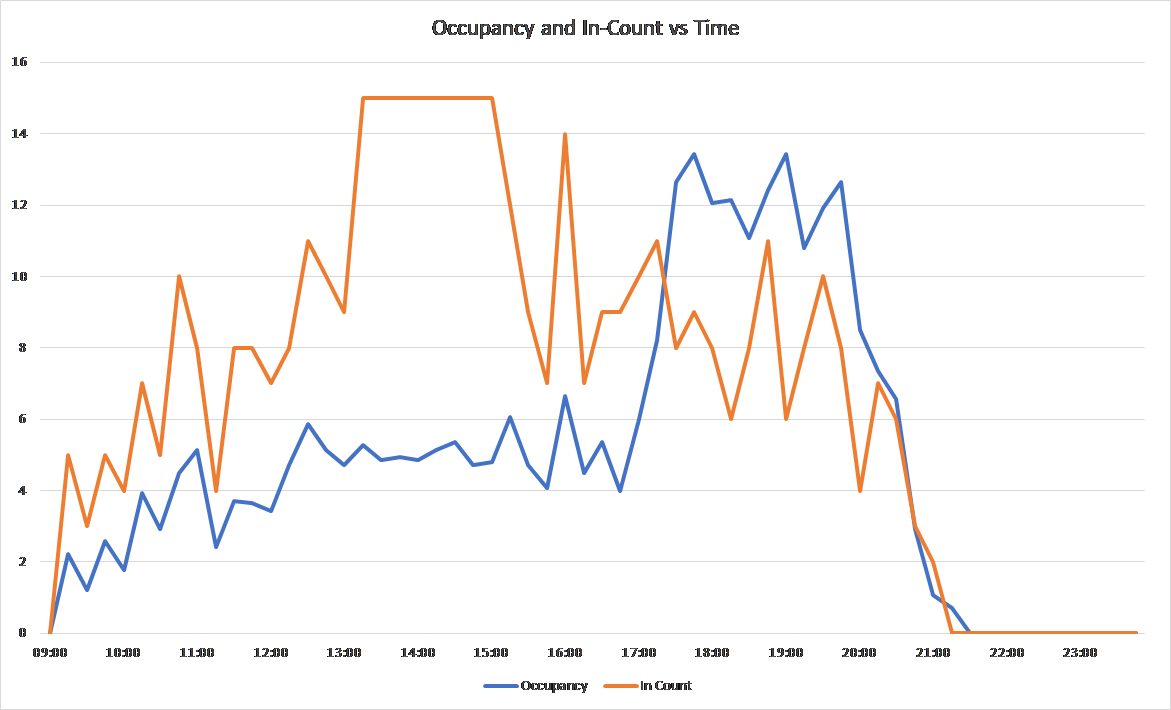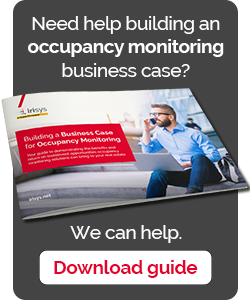Choosing the best occupancy sensor: 6 considerations to make before selection
More and more organisations are making investments in smart buildings technology, particularly occupancy analytics, but if you’re considering following suit what are the things you need to think about?
Occupancy sensors offer a wide range of benefits, including helping you to get more from the people and space you already have, improving energy efficiency and boosting employee productivity. There’s a wide range of technology available, but the industry has seen significant evolution in the last few years, so you need to think carefully about what you need and which sensor is most suited to your organisation.
What level of data does it provide?
Do you need to know how many people are in each room, or just which rooms are occupied and which are available? Some advanced sensors will even tell you how long a room has been occupied for.
Workplace occupancy sensors can go further, providing information about desk usage and availability. For example, desk level monitoring can tell you exactly which desks are available (if you operate a hot desking policy), while area, floor or building monitoring can tell you how many workstations are available in a given area. It depends on the level of detail you require.
Of course, you need to know the sensor you choose provides not just a deeper level of data, but accurate data. For example, Passive Infrared (PIR) sensors may be cheaper than other sensing technology, but they are less accurate and only able to report a binary occupied or unoccupied signal. For corporate environments, aim for an occupancy sensing technology that boasts accuracy rates of at least 99%.
If you'd like to find out more about how occupancy sensors can be used in your establishment take a look here.
Does it integrate?
One of the most powerful benefits of the Internet of Things and smart building technology is that workplace occupancy sensors can integrate with other building facilities, such as HVAC and lighting. This will save your organisation money, ensuring you’re only heating / cooling and lighting rooms when they’re occupied.
Some sensors can also integrate with facilities management systems, providing real time usage information to cleaners and maintenance staff. As an example, cleaners can attend toilets only after they have reached a specific level of usage, rather than at set times regardless of how much they have been used.
This not only ensures a higher level of room cleanliness during periods of higher use, but it also avoids unnecessary servicing during quieter periods.
How is it powered?
Occupancy sensors are either battery powered or connected to a permanent power supply - typically via a USB cable or Power over Ethernet (PoE) connection.
Although battery powered devices are ideal for short term analysis, for implementations that are intended to remain in place over a long period of time, a sensor that is connected to a power supply is a much more economical solution, as it will hugely reduce maintenance costs associated with regular battery replacements.
If a vendor is promoting a battery-powered unit and claiming ‘years’ of battery life, make sure you take a close look at the specifications. These sensors aren’t designed for real-time environments that require a high frequency of scanning, so it’s likely that either the battery won’t last as long as the vendor claims, or it won’t scan as often as you need.
We’d recommend PoE for workplace occupancy sensors. This is the most cost-effective solution as it means the sensor requires just one cable to power the device and transmit data. The True Occupancy sensor uses PoE and has an add-on PIR module that can boost accuracy even further.
How does the sensor connect to the network?
You have a number of different options for connecting the occupancy sensor to your organisation’s network.
Wireless (WiFi, SigFox, LoRa and Bluetooth), 4G or wired via PoE cable to a network switch are all options. When it comes to wireless and 4G connections, there can be security concerns, particularly when employees are connecting via multiple devices.
For PoE to network switch, this can either be connected to the organisation’s existing IT network, or be separate if the IT department don’t want it to touch their existing network. In this case, the network switch will have a built in 3/4G modem sim, and will be able to transit data to the cloud via the mobile network.
What do you need it for?
It is essential to consider your goals before making your occupancy sensor selection. By understanding what it is you want to measure and achieve, you can select an occupancy sensing technology that best suits your needs.
Do you want a fully integrated smart building system that delivers benefits across the whole organisation, or do you simply want to get a better understanding of how meeting rooms are being used?
Do you need real-time information? Do you want employees to have access to this information to improve their workplace experience with live availability of meeting rooms, break out areas, and even the lunch queue in the canteen?
Understanding your goals was the key advice from Simon Carter, Head of Corporate Property at National Grid, when we sat down with him to discuss implementing real-time analytics.
“Try to understand how you might deploy a system like True Occupancy. It’s easy to get carried away with trying to monitor every seat, every workstation, but what you need is usually a zonal approach.”
How does it keep anonymity?
With more advanced occupancy sensor technology, concerns over privacy can arise. While this is understandable, sensors are available that capture no personally identifiable information and protect the privacy of all building users.
When implementing an occupancy sensing solution, even ones that work anonymously, it is important you communicate clearly with your employees about what is being done. Employees in the workplace are often wary of being monitored, even if the intentions of management are good. We recommend involving employees from all levels in the project as this helps ensure they are bought into the solution, and concerns or objections can be answered.
True Occupancy workplace sensors utilise a Time of Flight sensor to anonymously detect people. This device was created using our extensive experience of counting people in retail environments and has a count accuracy in excess of 99%.
A quick summary and comparison of different occupancy sensing technologies:
| Solutions |
Manual Checks |
PIR |
Beam Break |
Cameras & CCTV |
Desk & Seat Sensor |
WiFi |
| Reason why alternative is not suitable |
Low accuracy as they will only provide a snapshot for a certain time frame |
Can only detect if a space is occupied or unoccupied |
Low accuracy, typically only counts in one direction |
Cameras & CCTV options are invasive and provide a violation to privacy |
Invasive, can only monitor usage where an area has a desk or seat |
Privacy concerns. People carrying multiple WiFi enabled devices may be counted multiple times |
| True Occupancy |
Captures exact occupancy & utilisation in real time |
Can provide the number of people in a room & how long they have been occupying the room for |
Bi-directional counting and multi functional sensors |
Collects no personally identifiable information. Protects anonymity and privacy |
Scalable and suitable for any room, floor or building |
AI and machine vision ensures only people are counted |
To find out more, download our free eBook The Truth bot Workplace Occupancy, alternatively get in touch with the True Occupancy team today.
Share this
You May Also Like
These Related Posts

How Workplace Occupancy Sensors Improve Employees’ Experience

Occupancy Data – Why Accuracy is Critical

Do You Have Clarity Over Your Building Occupancy?
Connect with us
Need more information? Ready to get started? We're here to help, get in touch.


